An Investigation into Gender Differences in Academic Motivation
VerifiedAdded on 2023/03/21
|45
|8901
|46
Report
AI Summary
This report investigates gender differences in academic motivation among university students. The study explores various motivational factors, including intrinsic, extrinsic, and amotivation, and their impact on academic performance. The research involved 100 undergraduate students, utilizing the Academic Motivation Scale (AMS) to assess different types of motivation. Statistical analyses, including Cronbach's alpha, were employed to ensure reliability and consistency. The findings highlight gender as a significant factor influencing motivation and its direct correlation with academic grades. The report also acknowledges the influence of other variables such as family background and teaching methods, while discussing the implications of the research and suggesting areas for further investigation. The study aims to determine whether significant differences exist in motivational behavior between male and female students and how these differences affect overall student performance. The report also includes an introduction, methods, results, discussion, and conclusion sections, along with references to support the findings.
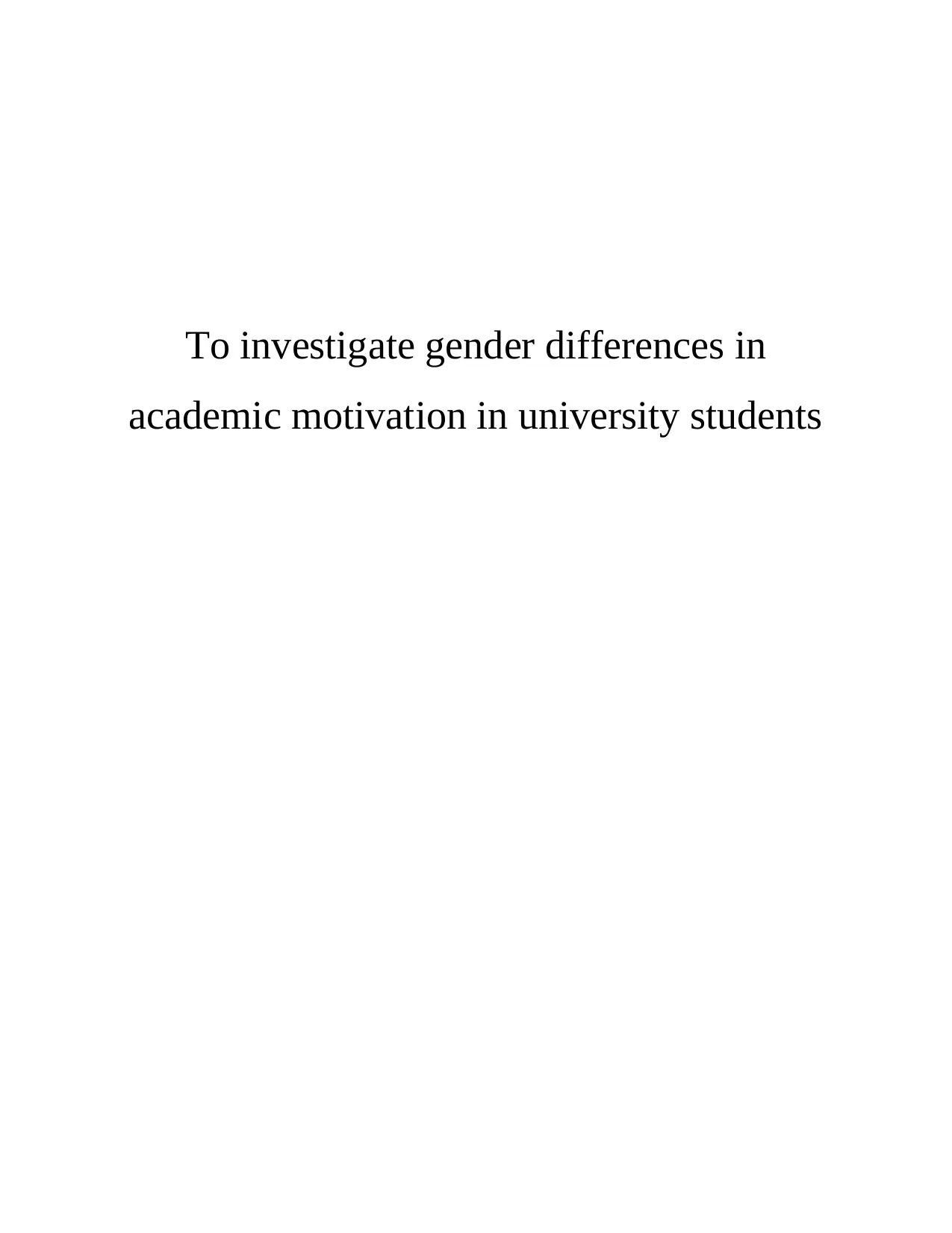
To investigate gender differences in
academic motivation in university students
academic motivation in university students
Paraphrase This Document
Need a fresh take? Get an instant paraphrase of this document with our AI Paraphraser
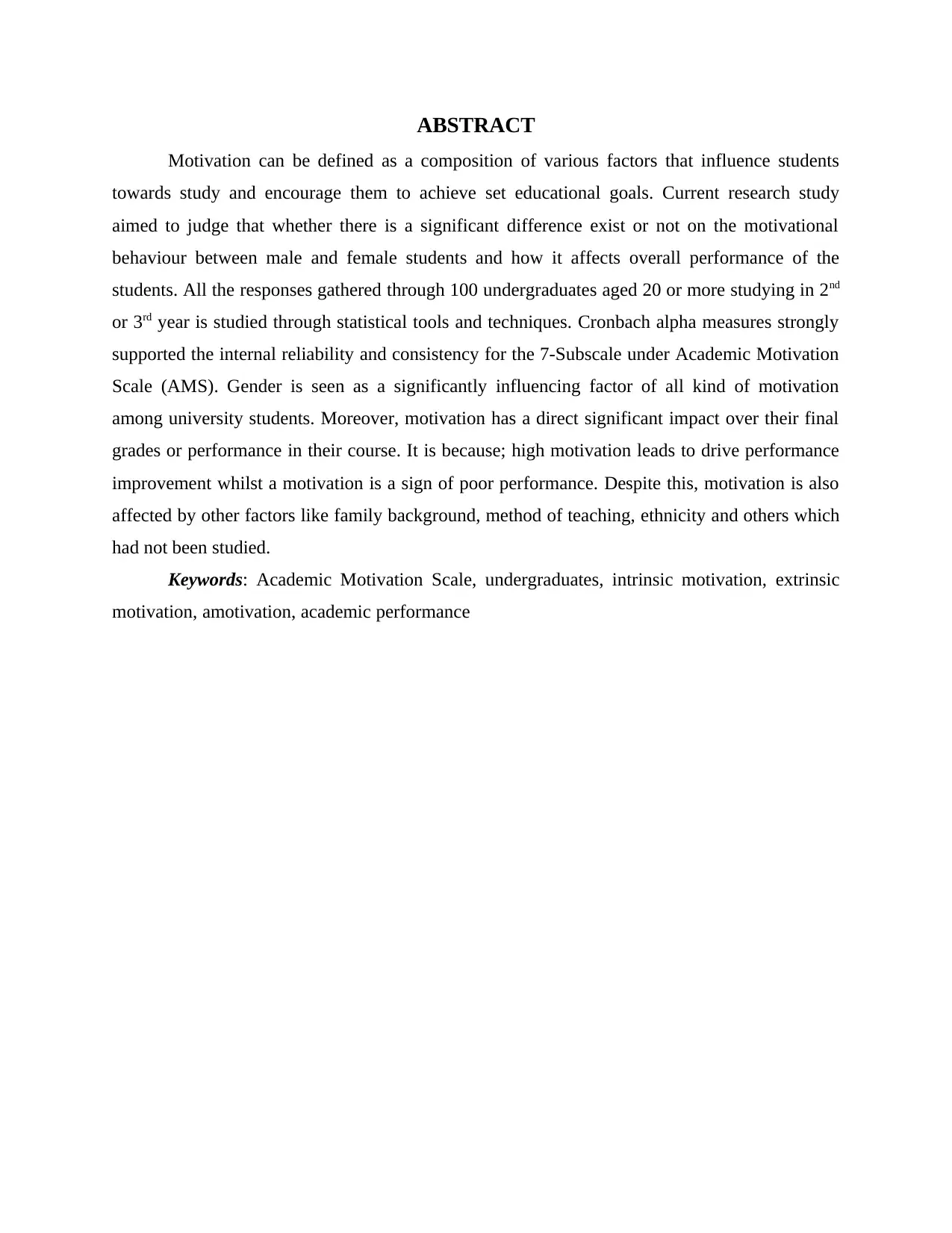
ABSTRACT
Motivation can be defined as a composition of various factors that influence students
towards study and encourage them to achieve set educational goals. Current research study
aimed to judge that whether there is a significant difference exist or not on the motivational
behaviour between male and female students and how it affects overall performance of the
students. All the responses gathered through 100 undergraduates aged 20 or more studying in 2nd
or 3rd year is studied through statistical tools and techniques. Cronbach alpha measures strongly
supported the internal reliability and consistency for the 7-Subscale under Academic Motivation
Scale (AMS). Gender is seen as a significantly influencing factor of all kind of motivation
among university students. Moreover, motivation has a direct significant impact over their final
grades or performance in their course. It is because; high motivation leads to drive performance
improvement whilst a motivation is a sign of poor performance. Despite this, motivation is also
affected by other factors like family background, method of teaching, ethnicity and others which
had not been studied.
Keywords: Academic Motivation Scale, undergraduates, intrinsic motivation, extrinsic
motivation, amotivation, academic performance
Motivation can be defined as a composition of various factors that influence students
towards study and encourage them to achieve set educational goals. Current research study
aimed to judge that whether there is a significant difference exist or not on the motivational
behaviour between male and female students and how it affects overall performance of the
students. All the responses gathered through 100 undergraduates aged 20 or more studying in 2nd
or 3rd year is studied through statistical tools and techniques. Cronbach alpha measures strongly
supported the internal reliability and consistency for the 7-Subscale under Academic Motivation
Scale (AMS). Gender is seen as a significantly influencing factor of all kind of motivation
among university students. Moreover, motivation has a direct significant impact over their final
grades or performance in their course. It is because; high motivation leads to drive performance
improvement whilst a motivation is a sign of poor performance. Despite this, motivation is also
affected by other factors like family background, method of teaching, ethnicity and others which
had not been studied.
Keywords: Academic Motivation Scale, undergraduates, intrinsic motivation, extrinsic
motivation, amotivation, academic performance
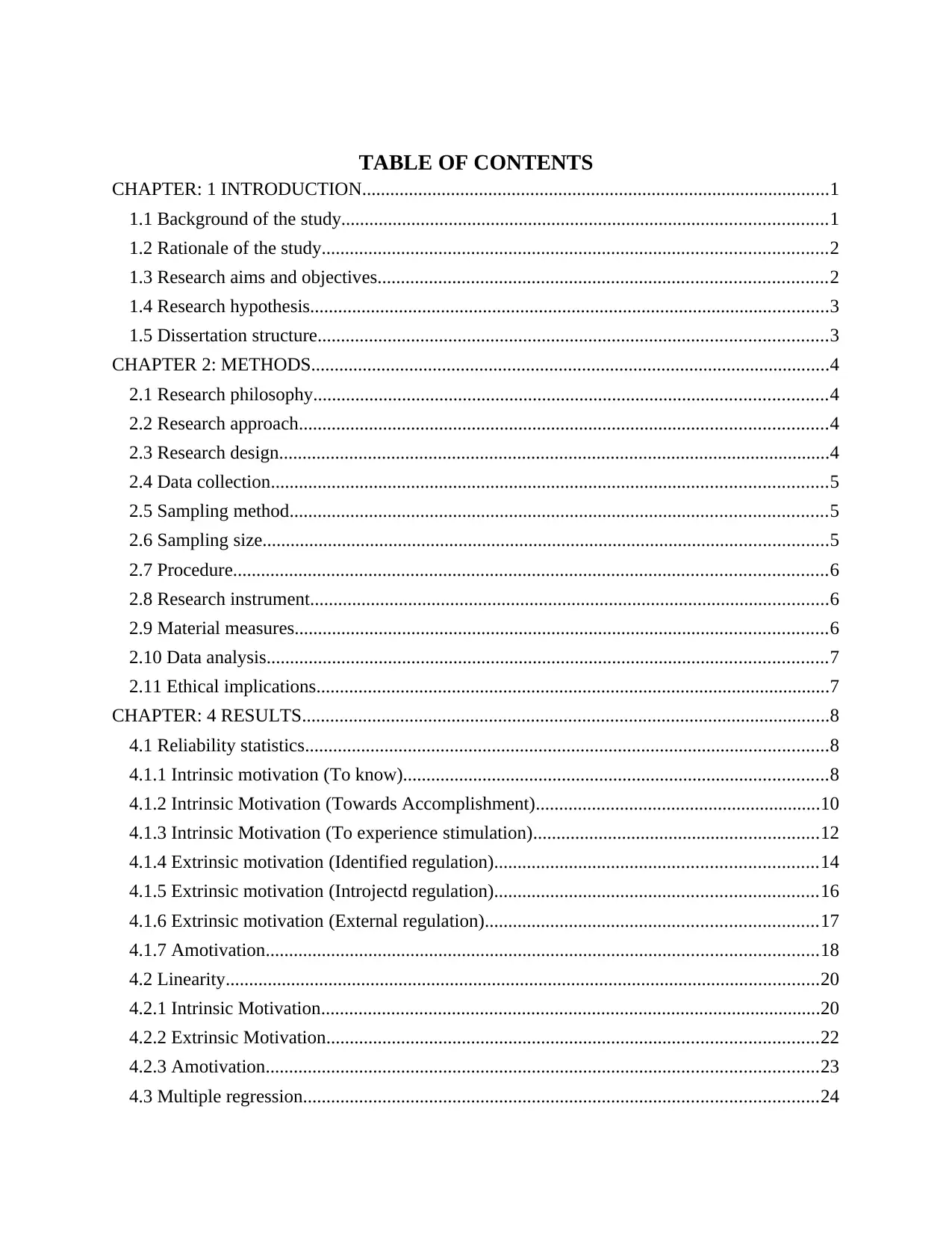
TABLE OF CONTENTS
CHAPTER: 1 INTRODUCTION....................................................................................................1
1.1 Background of the study........................................................................................................1
1.2 Rationale of the study............................................................................................................2
1.3 Research aims and objectives................................................................................................2
1.4 Research hypothesis...............................................................................................................3
1.5 Dissertation structure.............................................................................................................3
CHAPTER 2: METHODS...............................................................................................................4
2.1 Research philosophy..............................................................................................................4
2.2 Research approach.................................................................................................................4
2.3 Research design......................................................................................................................4
2.4 Data collection.......................................................................................................................5
2.5 Sampling method...................................................................................................................5
2.6 Sampling size.........................................................................................................................5
2.7 Procedure...............................................................................................................................6
2.8 Research instrument...............................................................................................................6
2.9 Material measures..................................................................................................................6
2.10 Data analysis........................................................................................................................7
2.11 Ethical implications..............................................................................................................7
CHAPTER: 4 RESULTS.................................................................................................................8
4.1 Reliability statistics................................................................................................................8
4.1.1 Intrinsic motivation (To know)...........................................................................................8
4.1.2 Intrinsic Motivation (Towards Accomplishment).............................................................10
4.1.3 Intrinsic Motivation (To experience stimulation).............................................................12
4.1.4 Extrinsic motivation (Identified regulation).....................................................................14
4.1.5 Extrinsic motivation (Introjectd regulation).....................................................................16
4.1.6 Extrinsic motivation (External regulation).......................................................................17
4.1.7 Amotivation......................................................................................................................18
4.2 Linearity...............................................................................................................................20
4.2.1 Intrinsic Motivation...........................................................................................................20
4.2.2 Extrinsic Motivation.........................................................................................................22
4.2.3 Amotivation......................................................................................................................23
4.3 Multiple regression..............................................................................................................24
CHAPTER: 1 INTRODUCTION....................................................................................................1
1.1 Background of the study........................................................................................................1
1.2 Rationale of the study............................................................................................................2
1.3 Research aims and objectives................................................................................................2
1.4 Research hypothesis...............................................................................................................3
1.5 Dissertation structure.............................................................................................................3
CHAPTER 2: METHODS...............................................................................................................4
2.1 Research philosophy..............................................................................................................4
2.2 Research approach.................................................................................................................4
2.3 Research design......................................................................................................................4
2.4 Data collection.......................................................................................................................5
2.5 Sampling method...................................................................................................................5
2.6 Sampling size.........................................................................................................................5
2.7 Procedure...............................................................................................................................6
2.8 Research instrument...............................................................................................................6
2.9 Material measures..................................................................................................................6
2.10 Data analysis........................................................................................................................7
2.11 Ethical implications..............................................................................................................7
CHAPTER: 4 RESULTS.................................................................................................................8
4.1 Reliability statistics................................................................................................................8
4.1.1 Intrinsic motivation (To know)...........................................................................................8
4.1.2 Intrinsic Motivation (Towards Accomplishment).............................................................10
4.1.3 Intrinsic Motivation (To experience stimulation).............................................................12
4.1.4 Extrinsic motivation (Identified regulation).....................................................................14
4.1.5 Extrinsic motivation (Introjectd regulation).....................................................................16
4.1.6 Extrinsic motivation (External regulation).......................................................................17
4.1.7 Amotivation......................................................................................................................18
4.2 Linearity...............................................................................................................................20
4.2.1 Intrinsic Motivation...........................................................................................................20
4.2.2 Extrinsic Motivation.........................................................................................................22
4.2.3 Amotivation......................................................................................................................23
4.3 Multiple regression..............................................................................................................24
⊘ This is a preview!⊘
Do you want full access?
Subscribe today to unlock all pages.

Trusted by 1+ million students worldwide
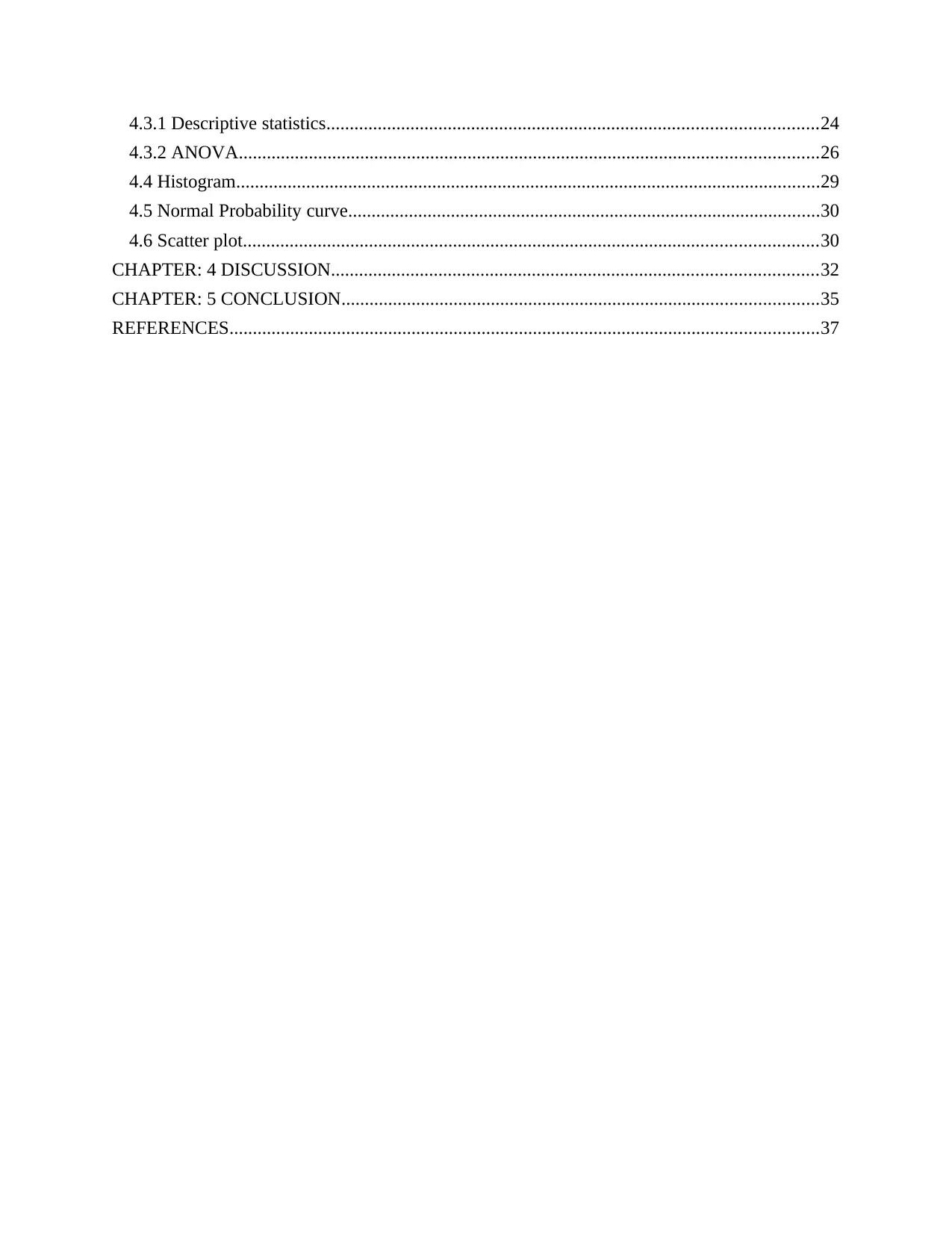
4.3.1 Descriptive statistics.........................................................................................................24
4.3.2 ANOVA............................................................................................................................26
4.4 Histogram.............................................................................................................................29
4.5 Normal Probability curve.....................................................................................................30
4.6 Scatter plot...........................................................................................................................30
CHAPTER: 4 DISCUSSION........................................................................................................32
CHAPTER: 5 CONCLUSION......................................................................................................35
REFERENCES..............................................................................................................................37
4.3.2 ANOVA............................................................................................................................26
4.4 Histogram.............................................................................................................................29
4.5 Normal Probability curve.....................................................................................................30
4.6 Scatter plot...........................................................................................................................30
CHAPTER: 4 DISCUSSION........................................................................................................32
CHAPTER: 5 CONCLUSION......................................................................................................35
REFERENCES..............................................................................................................................37
Paraphrase This Document
Need a fresh take? Get an instant paraphrase of this document with our AI Paraphraser
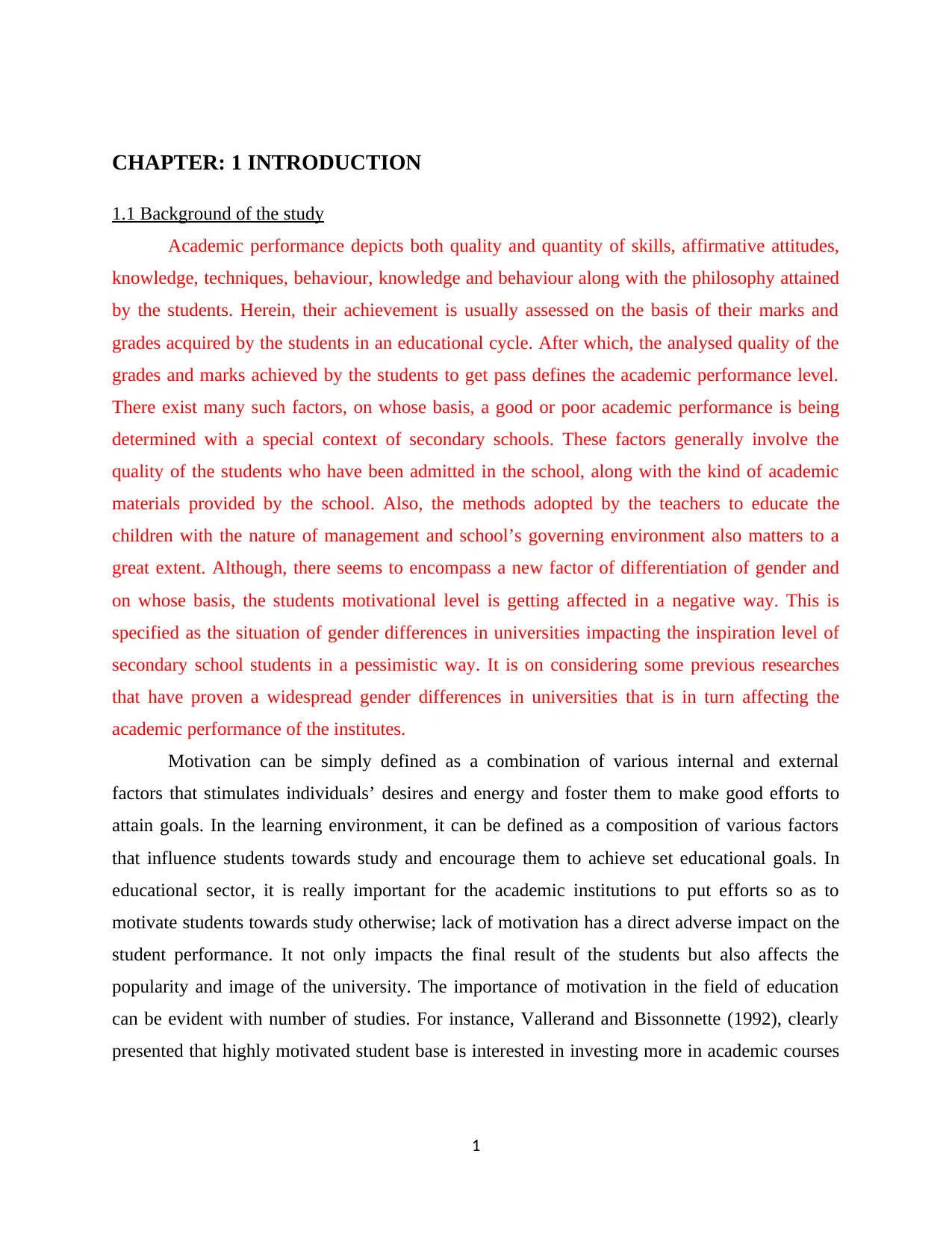
CHAPTER: 1 INTRODUCTION
1.1 Background of the study
Academic performance depicts both quality and quantity of skills, affirmative attitudes,
knowledge, techniques, behaviour, knowledge and behaviour along with the philosophy attained
by the students. Herein, their achievement is usually assessed on the basis of their marks and
grades acquired by the students in an educational cycle. After which, the analysed quality of the
grades and marks achieved by the students to get pass defines the academic performance level.
There exist many such factors, on whose basis, a good or poor academic performance is being
determined with a special context of secondary schools. These factors generally involve the
quality of the students who have been admitted in the school, along with the kind of academic
materials provided by the school. Also, the methods adopted by the teachers to educate the
children with the nature of management and school’s governing environment also matters to a
great extent. Although, there seems to encompass a new factor of differentiation of gender and
on whose basis, the students motivational level is getting affected in a negative way. This is
specified as the situation of gender differences in universities impacting the inspiration level of
secondary school students in a pessimistic way. It is on considering some previous researches
that have proven a widespread gender differences in universities that is in turn affecting the
academic performance of the institutes.
Motivation can be simply defined as a combination of various internal and external
factors that stimulates individuals’ desires and energy and foster them to make good efforts to
attain goals. In the learning environment, it can be defined as a composition of various factors
that influence students towards study and encourage them to achieve set educational goals. In
educational sector, it is really important for the academic institutions to put efforts so as to
motivate students towards study otherwise; lack of motivation has a direct adverse impact on the
student performance. It not only impacts the final result of the students but also affects the
popularity and image of the university. The importance of motivation in the field of education
can be evident with number of studies. For instance, Vallerand and Bissonnette (1992), clearly
presented that highly motivated student base is interested in investing more in academic courses
1
1.1 Background of the study
Academic performance depicts both quality and quantity of skills, affirmative attitudes,
knowledge, techniques, behaviour, knowledge and behaviour along with the philosophy attained
by the students. Herein, their achievement is usually assessed on the basis of their marks and
grades acquired by the students in an educational cycle. After which, the analysed quality of the
grades and marks achieved by the students to get pass defines the academic performance level.
There exist many such factors, on whose basis, a good or poor academic performance is being
determined with a special context of secondary schools. These factors generally involve the
quality of the students who have been admitted in the school, along with the kind of academic
materials provided by the school. Also, the methods adopted by the teachers to educate the
children with the nature of management and school’s governing environment also matters to a
great extent. Although, there seems to encompass a new factor of differentiation of gender and
on whose basis, the students motivational level is getting affected in a negative way. This is
specified as the situation of gender differences in universities impacting the inspiration level of
secondary school students in a pessimistic way. It is on considering some previous researches
that have proven a widespread gender differences in universities that is in turn affecting the
academic performance of the institutes.
Motivation can be simply defined as a combination of various internal and external
factors that stimulates individuals’ desires and energy and foster them to make good efforts to
attain goals. In the learning environment, it can be defined as a composition of various factors
that influence students towards study and encourage them to achieve set educational goals. In
educational sector, it is really important for the academic institutions to put efforts so as to
motivate students towards study otherwise; lack of motivation has a direct adverse impact on the
student performance. It not only impacts the final result of the students but also affects the
popularity and image of the university. The importance of motivation in the field of education
can be evident with number of studies. For instance, Vallerand and Bissonnette (1992), clearly
presented that highly motivated student base is interested in investing more in academic courses
1

and give their best efforts in achieving good grade. In contrast, lack of motivation fall student
performance as they are unlikely to devote time to study.
Academic motivational scale is considered to be an effective form that enables to an
effective form of method that is helpful enough for individuals to understand the rate of level
motivation that a person have. In order to perform any type of roles, it is requires to have certain
level of motivation so that the roles that has to be performed can carried out with their full
efficiency. There are some scales that are measured with the help of which individuals are
ranked. In this context, there are 5-point Likert scales from 0 to 7. Apart from this, it also
consists of five subscales assessing amotivation, external regulation, intrinsic motivation,
identified regulation and interjected regulation. Amotivation is represents nonregulated extreme
of continuum. Further, it is characterized by perception of individuals who have lack of purpose,
incompetence and control over events. In order to have completed any type of tasks it is required
to have proper time management so that all the activities are completed with speculated time
period. When a role is performed by a single person, then total time consumed will be high when
it is compared with same taken when performed by a group. In this context, students need to
have strong interaction with others so that they are able to perform their set of roles in effective
manner. Apart from this, the type of behaviour that is carried out by individuals also makes them
boosted up so that they can work in effective manner. Different people have diverse set of
perception. There will be people who face condition of stress due to the course that they have to
learn. Further, individuals can also face situation in which stress is due to assignments or
projects. It includes extrinsic motivation that falls under middle point mentioned continuum. It
includes constitutes like behaviour that is further divided into four subtypes of progressive
regulation, identified, interjected, external and integrated. Behaviour is enforced by others
depending upon the condition or situation that is faced. Further, it consists of providing
individuals with rewards and by avoiding punishments. Moreover, when talking about interjected
regulation, the type of behaviour that a person is mainly executed so that level of self esteem can
be improved. In addition to this, it is also done so that they are able to avoid anxiety and guilt. In
context, with identified regulations activities by extrinsic motives are selected by a person like
society values enrolling in superior studies. Lastly, it also covers intrinsic motivation which
occupies autonomous regulations pole in which pleasure of executing behaviours by making
choice of prevails.
2
performance as they are unlikely to devote time to study.
Academic motivational scale is considered to be an effective form that enables to an
effective form of method that is helpful enough for individuals to understand the rate of level
motivation that a person have. In order to perform any type of roles, it is requires to have certain
level of motivation so that the roles that has to be performed can carried out with their full
efficiency. There are some scales that are measured with the help of which individuals are
ranked. In this context, there are 5-point Likert scales from 0 to 7. Apart from this, it also
consists of five subscales assessing amotivation, external regulation, intrinsic motivation,
identified regulation and interjected regulation. Amotivation is represents nonregulated extreme
of continuum. Further, it is characterized by perception of individuals who have lack of purpose,
incompetence and control over events. In order to have completed any type of tasks it is required
to have proper time management so that all the activities are completed with speculated time
period. When a role is performed by a single person, then total time consumed will be high when
it is compared with same taken when performed by a group. In this context, students need to
have strong interaction with others so that they are able to perform their set of roles in effective
manner. Apart from this, the type of behaviour that is carried out by individuals also makes them
boosted up so that they can work in effective manner. Different people have diverse set of
perception. There will be people who face condition of stress due to the course that they have to
learn. Further, individuals can also face situation in which stress is due to assignments or
projects. It includes extrinsic motivation that falls under middle point mentioned continuum. It
includes constitutes like behaviour that is further divided into four subtypes of progressive
regulation, identified, interjected, external and integrated. Behaviour is enforced by others
depending upon the condition or situation that is faced. Further, it consists of providing
individuals with rewards and by avoiding punishments. Moreover, when talking about interjected
regulation, the type of behaviour that a person is mainly executed so that level of self esteem can
be improved. In addition to this, it is also done so that they are able to avoid anxiety and guilt. In
context, with identified regulations activities by extrinsic motives are selected by a person like
society values enrolling in superior studies. Lastly, it also covers intrinsic motivation which
occupies autonomous regulations pole in which pleasure of executing behaviours by making
choice of prevails.
2
⊘ This is a preview!⊘
Do you want full access?
Subscribe today to unlock all pages.

Trusted by 1+ million students worldwide
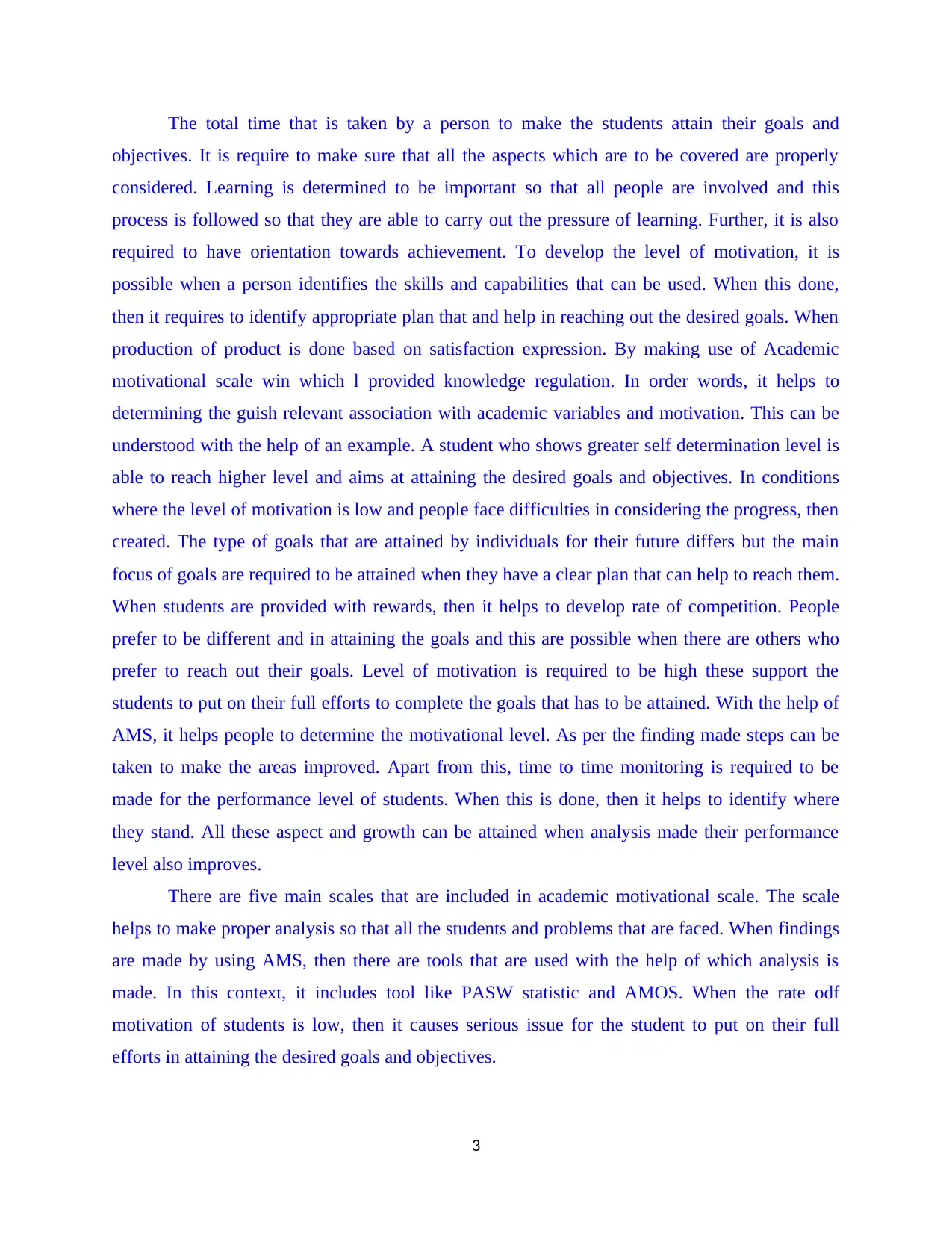
The total time that is taken by a person to make the students attain their goals and
objectives. It is require to make sure that all the aspects which are to be covered are properly
considered. Learning is determined to be important so that all people are involved and this
process is followed so that they are able to carry out the pressure of learning. Further, it is also
required to have orientation towards achievement. To develop the level of motivation, it is
possible when a person identifies the skills and capabilities that can be used. When this done,
then it requires to identify appropriate plan that and help in reaching out the desired goals. When
production of product is done based on satisfaction expression. By making use of Academic
motivational scale win which l provided knowledge regulation. In order words, it helps to
determining the guish relevant association with academic variables and motivation. This can be
understood with the help of an example. A student who shows greater self determination level is
able to reach higher level and aims at attaining the desired goals and objectives. In conditions
where the level of motivation is low and people face difficulties in considering the progress, then
created. The type of goals that are attained by individuals for their future differs but the main
focus of goals are required to be attained when they have a clear plan that can help to reach them.
When students are provided with rewards, then it helps to develop rate of competition. People
prefer to be different and in attaining the goals and this are possible when there are others who
prefer to reach out their goals. Level of motivation is required to be high these support the
students to put on their full efforts to complete the goals that has to be attained. With the help of
AMS, it helps people to determine the motivational level. As per the finding made steps can be
taken to make the areas improved. Apart from this, time to time monitoring is required to be
made for the performance level of students. When this is done, then it helps to identify where
they stand. All these aspect and growth can be attained when analysis made their performance
level also improves.
There are five main scales that are included in academic motivational scale. The scale
helps to make proper analysis so that all the students and problems that are faced. When findings
are made by using AMS, then there are tools that are used with the help of which analysis is
made. In this context, it includes tool like PASW statistic and AMOS. When the rate odf
motivation of students is low, then it causes serious issue for the student to put on their full
efforts in attaining the desired goals and objectives.
3
objectives. It is require to make sure that all the aspects which are to be covered are properly
considered. Learning is determined to be important so that all people are involved and this
process is followed so that they are able to carry out the pressure of learning. Further, it is also
required to have orientation towards achievement. To develop the level of motivation, it is
possible when a person identifies the skills and capabilities that can be used. When this done,
then it requires to identify appropriate plan that and help in reaching out the desired goals. When
production of product is done based on satisfaction expression. By making use of Academic
motivational scale win which l provided knowledge regulation. In order words, it helps to
determining the guish relevant association with academic variables and motivation. This can be
understood with the help of an example. A student who shows greater self determination level is
able to reach higher level and aims at attaining the desired goals and objectives. In conditions
where the level of motivation is low and people face difficulties in considering the progress, then
created. The type of goals that are attained by individuals for their future differs but the main
focus of goals are required to be attained when they have a clear plan that can help to reach them.
When students are provided with rewards, then it helps to develop rate of competition. People
prefer to be different and in attaining the goals and this are possible when there are others who
prefer to reach out their goals. Level of motivation is required to be high these support the
students to put on their full efforts to complete the goals that has to be attained. With the help of
AMS, it helps people to determine the motivational level. As per the finding made steps can be
taken to make the areas improved. Apart from this, time to time monitoring is required to be
made for the performance level of students. When this is done, then it helps to identify where
they stand. All these aspect and growth can be attained when analysis made their performance
level also improves.
There are five main scales that are included in academic motivational scale. The scale
helps to make proper analysis so that all the students and problems that are faced. When findings
are made by using AMS, then there are tools that are used with the help of which analysis is
made. In this context, it includes tool like PASW statistic and AMOS. When the rate odf
motivation of students is low, then it causes serious issue for the student to put on their full
efforts in attaining the desired goals and objectives.
3
Paraphrase This Document
Need a fresh take? Get an instant paraphrase of this document with our AI Paraphraser
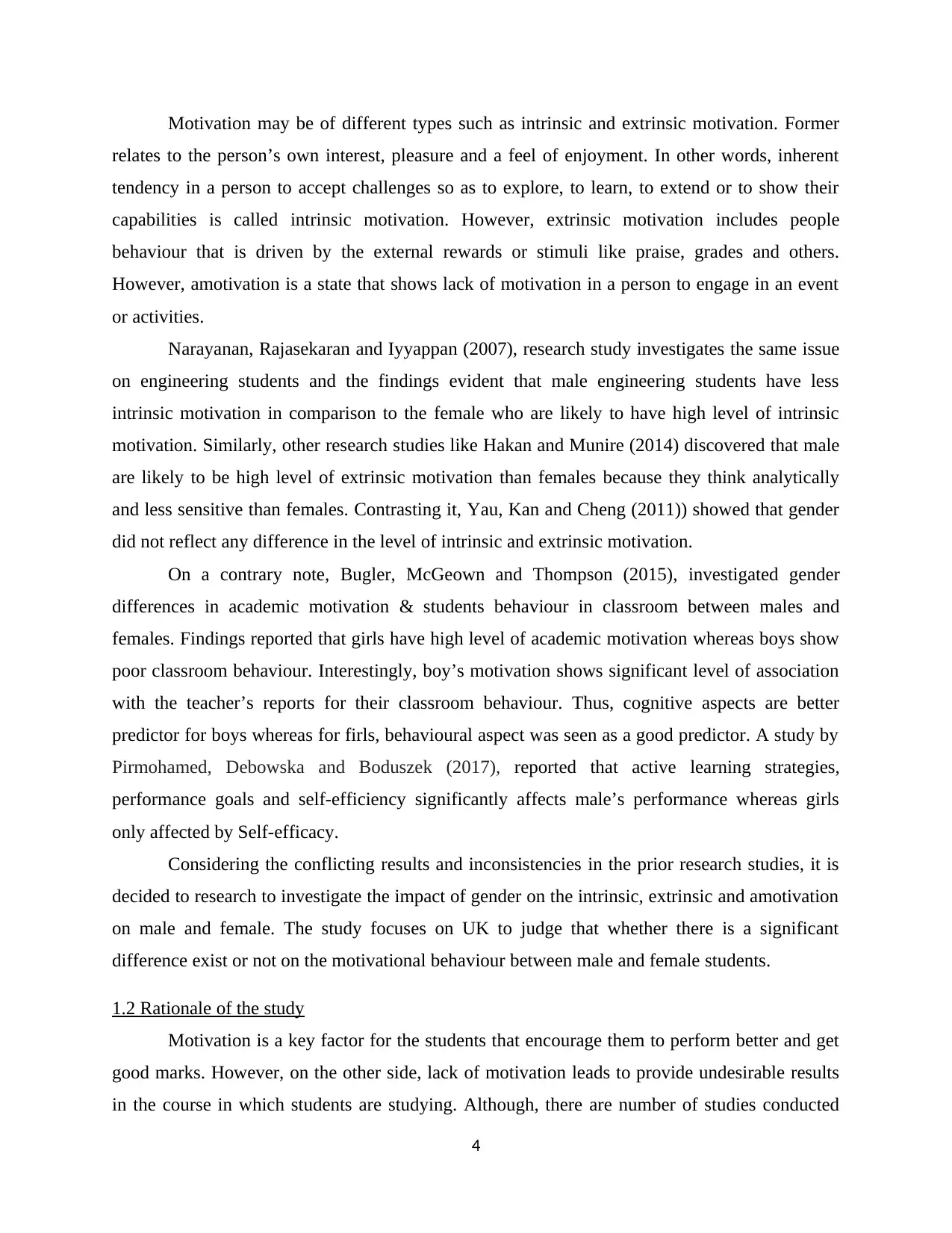
Motivation may be of different types such as intrinsic and extrinsic motivation. Former
relates to the person’s own interest, pleasure and a feel of enjoyment. In other words, inherent
tendency in a person to accept challenges so as to explore, to learn, to extend or to show their
capabilities is called intrinsic motivation. However, extrinsic motivation includes people
behaviour that is driven by the external rewards or stimuli like praise, grades and others.
However, amotivation is a state that shows lack of motivation in a person to engage in an event
or activities.
Narayanan, Rajasekaran and Iyyappan (2007), research study investigates the same issue
on engineering students and the findings evident that male engineering students have less
intrinsic motivation in comparison to the female who are likely to have high level of intrinsic
motivation. Similarly, other research studies like Hakan and Munire (2014) discovered that male
are likely to be high level of extrinsic motivation than females because they think analytically
and less sensitive than females. Contrasting it, Yau, Kan and Cheng (2011)) showed that gender
did not reflect any difference in the level of intrinsic and extrinsic motivation.
On a contrary note, Bugler, McGeown and Thompson (2015), investigated gender
differences in academic motivation & students behaviour in classroom between males and
females. Findings reported that girls have high level of academic motivation whereas boys show
poor classroom behaviour. Interestingly, boy’s motivation shows significant level of association
with the teacher’s reports for their classroom behaviour. Thus, cognitive aspects are better
predictor for boys whereas for firls, behavioural aspect was seen as a good predictor. A study by
Pirmohamed, Debowska and Boduszek (2017), reported that active learning strategies,
performance goals and self-efficiency significantly affects male’s performance whereas girls
only affected by Self-efficacy.
Considering the conflicting results and inconsistencies in the prior research studies, it is
decided to research to investigate the impact of gender on the intrinsic, extrinsic and amotivation
on male and female. The study focuses on UK to judge that whether there is a significant
difference exist or not on the motivational behaviour between male and female students.
1.2 Rationale of the study
Motivation is a key factor for the students that encourage them to perform better and get
good marks. However, on the other side, lack of motivation leads to provide undesirable results
in the course in which students are studying. Although, there are number of studies conducted
4
relates to the person’s own interest, pleasure and a feel of enjoyment. In other words, inherent
tendency in a person to accept challenges so as to explore, to learn, to extend or to show their
capabilities is called intrinsic motivation. However, extrinsic motivation includes people
behaviour that is driven by the external rewards or stimuli like praise, grades and others.
However, amotivation is a state that shows lack of motivation in a person to engage in an event
or activities.
Narayanan, Rajasekaran and Iyyappan (2007), research study investigates the same issue
on engineering students and the findings evident that male engineering students have less
intrinsic motivation in comparison to the female who are likely to have high level of intrinsic
motivation. Similarly, other research studies like Hakan and Munire (2014) discovered that male
are likely to be high level of extrinsic motivation than females because they think analytically
and less sensitive than females. Contrasting it, Yau, Kan and Cheng (2011)) showed that gender
did not reflect any difference in the level of intrinsic and extrinsic motivation.
On a contrary note, Bugler, McGeown and Thompson (2015), investigated gender
differences in academic motivation & students behaviour in classroom between males and
females. Findings reported that girls have high level of academic motivation whereas boys show
poor classroom behaviour. Interestingly, boy’s motivation shows significant level of association
with the teacher’s reports for their classroom behaviour. Thus, cognitive aspects are better
predictor for boys whereas for firls, behavioural aspect was seen as a good predictor. A study by
Pirmohamed, Debowska and Boduszek (2017), reported that active learning strategies,
performance goals and self-efficiency significantly affects male’s performance whereas girls
only affected by Self-efficacy.
Considering the conflicting results and inconsistencies in the prior research studies, it is
decided to research to investigate the impact of gender on the intrinsic, extrinsic and amotivation
on male and female. The study focuses on UK to judge that whether there is a significant
difference exist or not on the motivational behaviour between male and female students.
1.2 Rationale of the study
Motivation is a key factor for the students that encourage them to perform better and get
good marks. However, on the other side, lack of motivation leads to provide undesirable results
in the course in which students are studying. Although, there are number of studies conducted
4
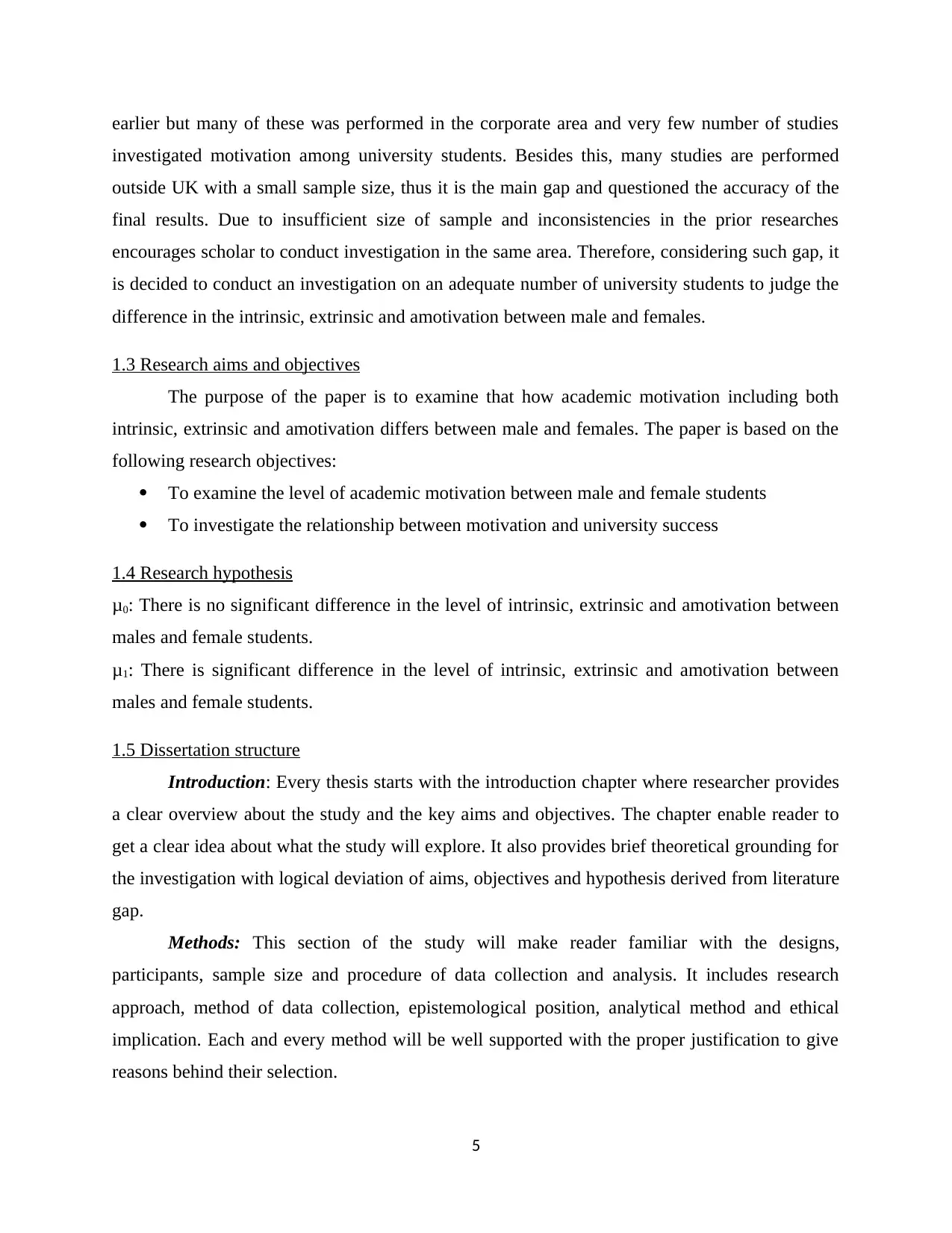
earlier but many of these was performed in the corporate area and very few number of studies
investigated motivation among university students. Besides this, many studies are performed
outside UK with a small sample size, thus it is the main gap and questioned the accuracy of the
final results. Due to insufficient size of sample and inconsistencies in the prior researches
encourages scholar to conduct investigation in the same area. Therefore, considering such gap, it
is decided to conduct an investigation on an adequate number of university students to judge the
difference in the intrinsic, extrinsic and amotivation between male and females.
1.3 Research aims and objectives
The purpose of the paper is to examine that how academic motivation including both
intrinsic, extrinsic and amotivation differs between male and females. The paper is based on the
following research objectives:
To examine the level of academic motivation between male and female students
To investigate the relationship between motivation and university success
1.4 Research hypothesis
μ0: There is no significant difference in the level of intrinsic, extrinsic and amotivation between
males and female students.
μ1: There is significant difference in the level of intrinsic, extrinsic and amotivation between
males and female students.
1.5 Dissertation structure
Introduction: Every thesis starts with the introduction chapter where researcher provides
a clear overview about the study and the key aims and objectives. The chapter enable reader to
get a clear idea about what the study will explore. It also provides brief theoretical grounding for
the investigation with logical deviation of aims, objectives and hypothesis derived from literature
gap.
Methods: This section of the study will make reader familiar with the designs,
participants, sample size and procedure of data collection and analysis. It includes research
approach, method of data collection, epistemological position, analytical method and ethical
implication. Each and every method will be well supported with the proper justification to give
reasons behind their selection.
5
investigated motivation among university students. Besides this, many studies are performed
outside UK with a small sample size, thus it is the main gap and questioned the accuracy of the
final results. Due to insufficient size of sample and inconsistencies in the prior researches
encourages scholar to conduct investigation in the same area. Therefore, considering such gap, it
is decided to conduct an investigation on an adequate number of university students to judge the
difference in the intrinsic, extrinsic and amotivation between male and females.
1.3 Research aims and objectives
The purpose of the paper is to examine that how academic motivation including both
intrinsic, extrinsic and amotivation differs between male and females. The paper is based on the
following research objectives:
To examine the level of academic motivation between male and female students
To investigate the relationship between motivation and university success
1.4 Research hypothesis
μ0: There is no significant difference in the level of intrinsic, extrinsic and amotivation between
males and female students.
μ1: There is significant difference in the level of intrinsic, extrinsic and amotivation between
males and female students.
1.5 Dissertation structure
Introduction: Every thesis starts with the introduction chapter where researcher provides
a clear overview about the study and the key aims and objectives. The chapter enable reader to
get a clear idea about what the study will explore. It also provides brief theoretical grounding for
the investigation with logical deviation of aims, objectives and hypothesis derived from literature
gap.
Methods: This section of the study will make reader familiar with the designs,
participants, sample size and procedure of data collection and analysis. It includes research
approach, method of data collection, epistemological position, analytical method and ethical
implication. Each and every method will be well supported with the proper justification to give
reasons behind their selection.
5
⊘ This is a preview!⊘
Do you want full access?
Subscribe today to unlock all pages.

Trusted by 1+ million students worldwide
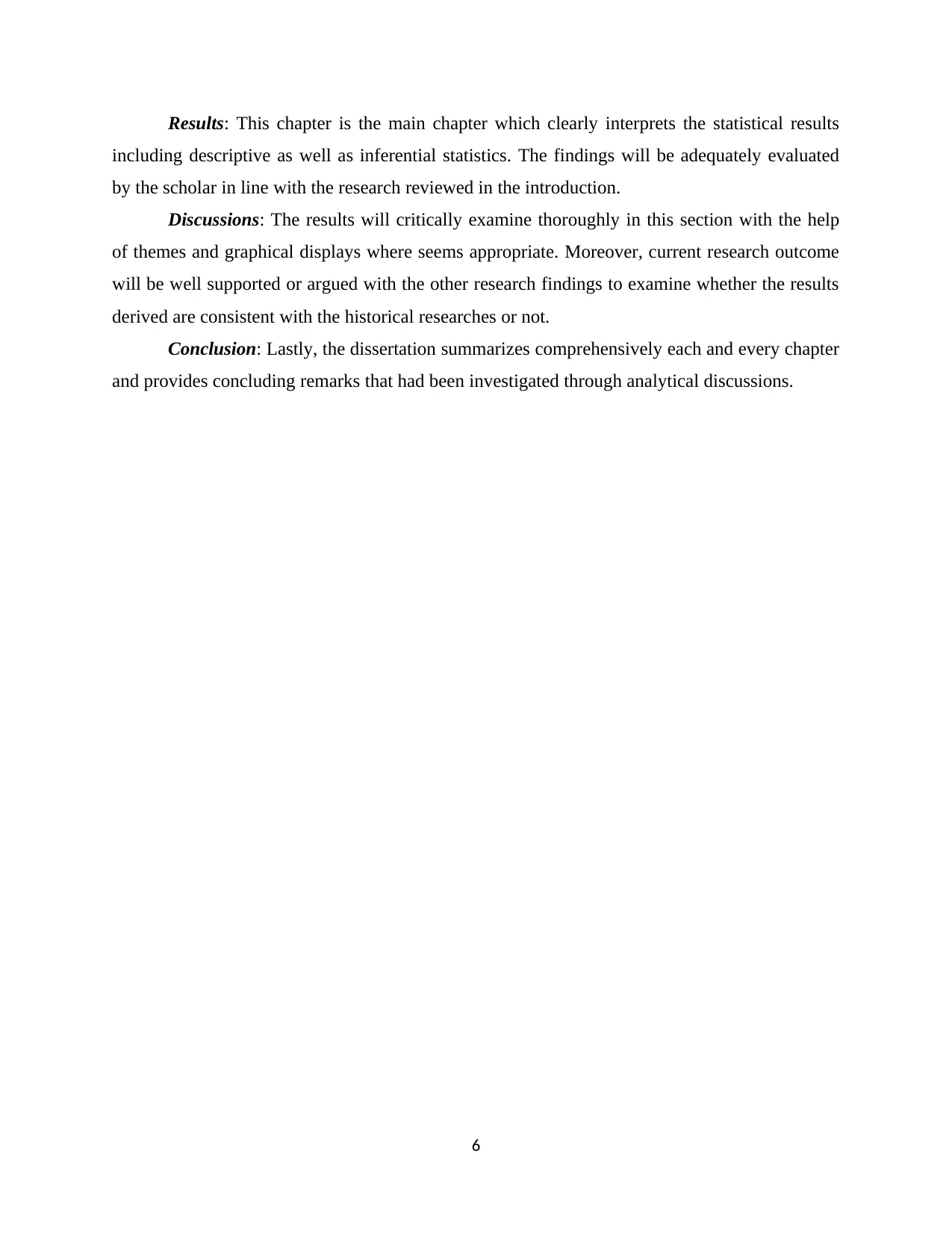
Results: This chapter is the main chapter which clearly interprets the statistical results
including descriptive as well as inferential statistics. The findings will be adequately evaluated
by the scholar in line with the research reviewed in the introduction.
Discussions: The results will critically examine thoroughly in this section with the help
of themes and graphical displays where seems appropriate. Moreover, current research outcome
will be well supported or argued with the other research findings to examine whether the results
derived are consistent with the historical researches or not.
Conclusion: Lastly, the dissertation summarizes comprehensively each and every chapter
and provides concluding remarks that had been investigated through analytical discussions.
6
including descriptive as well as inferential statistics. The findings will be adequately evaluated
by the scholar in line with the research reviewed in the introduction.
Discussions: The results will critically examine thoroughly in this section with the help
of themes and graphical displays where seems appropriate. Moreover, current research outcome
will be well supported or argued with the other research findings to examine whether the results
derived are consistent with the historical researches or not.
Conclusion: Lastly, the dissertation summarizes comprehensively each and every chapter
and provides concluding remarks that had been investigated through analytical discussions.
6
Paraphrase This Document
Need a fresh take? Get an instant paraphrase of this document with our AI Paraphraser
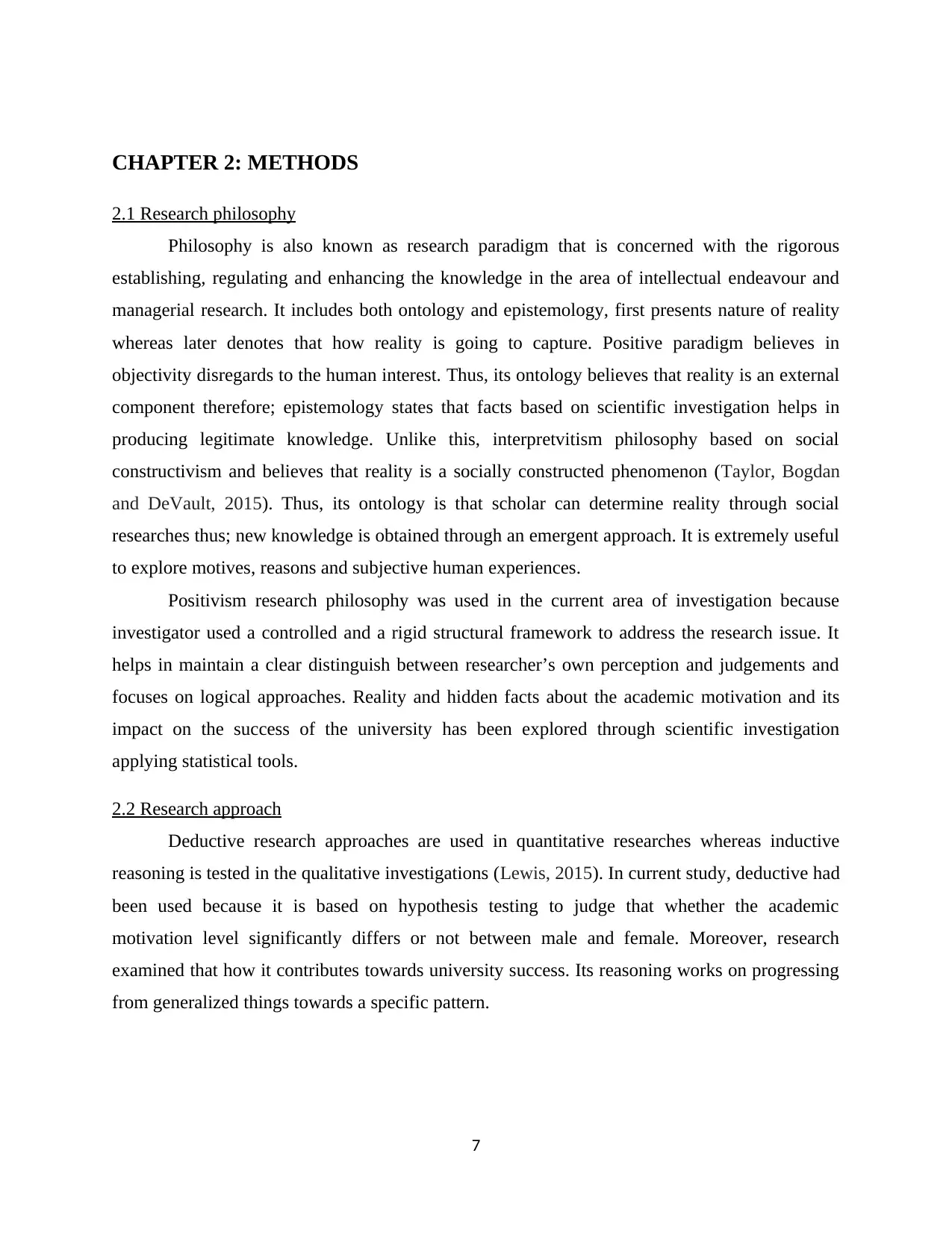
CHAPTER 2: METHODS
2.1 Research philosophy
Philosophy is also known as research paradigm that is concerned with the rigorous
establishing, regulating and enhancing the knowledge in the area of intellectual endeavour and
managerial research. It includes both ontology and epistemology, first presents nature of reality
whereas later denotes that how reality is going to capture. Positive paradigm believes in
objectivity disregards to the human interest. Thus, its ontology believes that reality is an external
component therefore; epistemology states that facts based on scientific investigation helps in
producing legitimate knowledge. Unlike this, interpretvitism philosophy based on social
constructivism and believes that reality is a socially constructed phenomenon (Taylor, Bogdan
and DeVault, 2015). Thus, its ontology is that scholar can determine reality through social
researches thus; new knowledge is obtained through an emergent approach. It is extremely useful
to explore motives, reasons and subjective human experiences.
Positivism research philosophy was used in the current area of investigation because
investigator used a controlled and a rigid structural framework to address the research issue. It
helps in maintain a clear distinguish between researcher’s own perception and judgements and
focuses on logical approaches. Reality and hidden facts about the academic motivation and its
impact on the success of the university has been explored through scientific investigation
applying statistical tools.
2.2 Research approach
Deductive research approaches are used in quantitative researches whereas inductive
reasoning is tested in the qualitative investigations (Lewis, 2015). In current study, deductive had
been used because it is based on hypothesis testing to judge that whether the academic
motivation level significantly differs or not between male and female. Moreover, research
examined that how it contributes towards university success. Its reasoning works on progressing
from generalized things towards a specific pattern.
7
2.1 Research philosophy
Philosophy is also known as research paradigm that is concerned with the rigorous
establishing, regulating and enhancing the knowledge in the area of intellectual endeavour and
managerial research. It includes both ontology and epistemology, first presents nature of reality
whereas later denotes that how reality is going to capture. Positive paradigm believes in
objectivity disregards to the human interest. Thus, its ontology believes that reality is an external
component therefore; epistemology states that facts based on scientific investigation helps in
producing legitimate knowledge. Unlike this, interpretvitism philosophy based on social
constructivism and believes that reality is a socially constructed phenomenon (Taylor, Bogdan
and DeVault, 2015). Thus, its ontology is that scholar can determine reality through social
researches thus; new knowledge is obtained through an emergent approach. It is extremely useful
to explore motives, reasons and subjective human experiences.
Positivism research philosophy was used in the current area of investigation because
investigator used a controlled and a rigid structural framework to address the research issue. It
helps in maintain a clear distinguish between researcher’s own perception and judgements and
focuses on logical approaches. Reality and hidden facts about the academic motivation and its
impact on the success of the university has been explored through scientific investigation
applying statistical tools.
2.2 Research approach
Deductive research approaches are used in quantitative researches whereas inductive
reasoning is tested in the qualitative investigations (Lewis, 2015). In current study, deductive had
been used because it is based on hypothesis testing to judge that whether the academic
motivation level significantly differs or not between male and female. Moreover, research
examined that how it contributes towards university success. Its reasoning works on progressing
from generalized things towards a specific pattern.
7
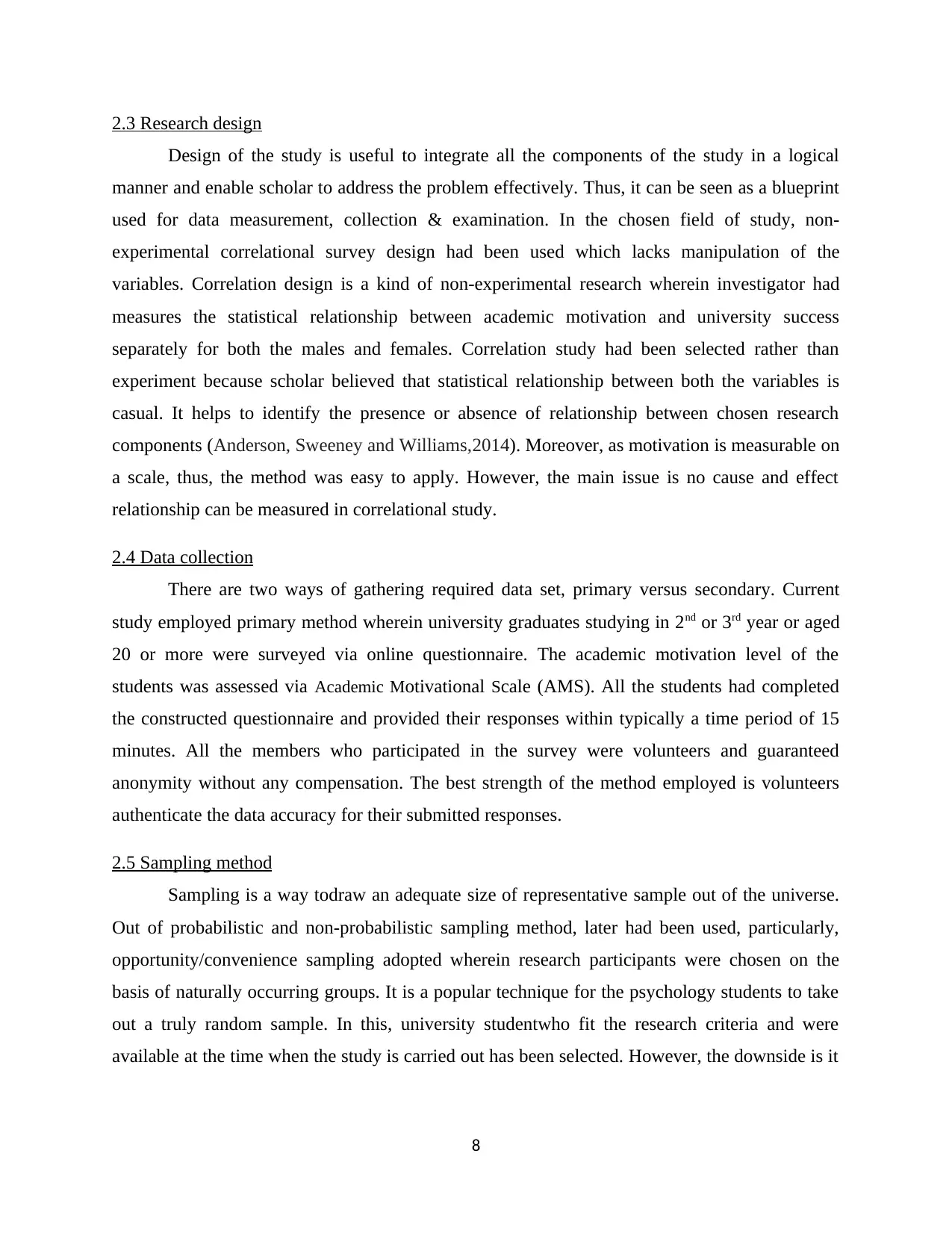
2.3 Research design
Design of the study is useful to integrate all the components of the study in a logical
manner and enable scholar to address the problem effectively. Thus, it can be seen as a blueprint
used for data measurement, collection & examination. In the chosen field of study, non-
experimental correlational survey design had been used which lacks manipulation of the
variables. Correlation design is a kind of non-experimental research wherein investigator had
measures the statistical relationship between academic motivation and university success
separately for both the males and females. Correlation study had been selected rather than
experiment because scholar believed that statistical relationship between both the variables is
casual. It helps to identify the presence or absence of relationship between chosen research
components (Anderson, Sweeney and Williams,2014). Moreover, as motivation is measurable on
a scale, thus, the method was easy to apply. However, the main issue is no cause and effect
relationship can be measured in correlational study.
2.4 Data collection
There are two ways of gathering required data set, primary versus secondary. Current
study employed primary method wherein university graduates studying in 2nd or 3rd year or aged
20 or more were surveyed via online questionnaire. The academic motivation level of the
students was assessed via Academic Motivational Scale (AMS). All the students had completed
the constructed questionnaire and provided their responses within typically a time period of 15
minutes. All the members who participated in the survey were volunteers and guaranteed
anonymity without any compensation. The best strength of the method employed is volunteers
authenticate the data accuracy for their submitted responses.
2.5 Sampling method
Sampling is a way todraw an adequate size of representative sample out of the universe.
Out of probabilistic and non-probabilistic sampling method, later had been used, particularly,
opportunity/convenience sampling adopted wherein research participants were chosen on the
basis of naturally occurring groups. It is a popular technique for the psychology students to take
out a truly random sample. In this, university studentwho fit the research criteria and were
available at the time when the study is carried out has been selected. However, the downside is it
8
Design of the study is useful to integrate all the components of the study in a logical
manner and enable scholar to address the problem effectively. Thus, it can be seen as a blueprint
used for data measurement, collection & examination. In the chosen field of study, non-
experimental correlational survey design had been used which lacks manipulation of the
variables. Correlation design is a kind of non-experimental research wherein investigator had
measures the statistical relationship between academic motivation and university success
separately for both the males and females. Correlation study had been selected rather than
experiment because scholar believed that statistical relationship between both the variables is
casual. It helps to identify the presence or absence of relationship between chosen research
components (Anderson, Sweeney and Williams,2014). Moreover, as motivation is measurable on
a scale, thus, the method was easy to apply. However, the main issue is no cause and effect
relationship can be measured in correlational study.
2.4 Data collection
There are two ways of gathering required data set, primary versus secondary. Current
study employed primary method wherein university graduates studying in 2nd or 3rd year or aged
20 or more were surveyed via online questionnaire. The academic motivation level of the
students was assessed via Academic Motivational Scale (AMS). All the students had completed
the constructed questionnaire and provided their responses within typically a time period of 15
minutes. All the members who participated in the survey were volunteers and guaranteed
anonymity without any compensation. The best strength of the method employed is volunteers
authenticate the data accuracy for their submitted responses.
2.5 Sampling method
Sampling is a way todraw an adequate size of representative sample out of the universe.
Out of probabilistic and non-probabilistic sampling method, later had been used, particularly,
opportunity/convenience sampling adopted wherein research participants were chosen on the
basis of naturally occurring groups. It is a popular technique for the psychology students to take
out a truly random sample. In this, university studentwho fit the research criteria and were
available at the time when the study is carried out has been selected. However, the downside is it
8
⊘ This is a preview!⊘
Do you want full access?
Subscribe today to unlock all pages.

Trusted by 1+ million students worldwide
1 out of 45
Related Documents
Your All-in-One AI-Powered Toolkit for Academic Success.
+13062052269
info@desklib.com
Available 24*7 on WhatsApp / Email
![[object Object]](/_next/static/media/star-bottom.7253800d.svg)
Unlock your academic potential
Copyright © 2020–2025 A2Z Services. All Rights Reserved. Developed and managed by ZUCOL.





